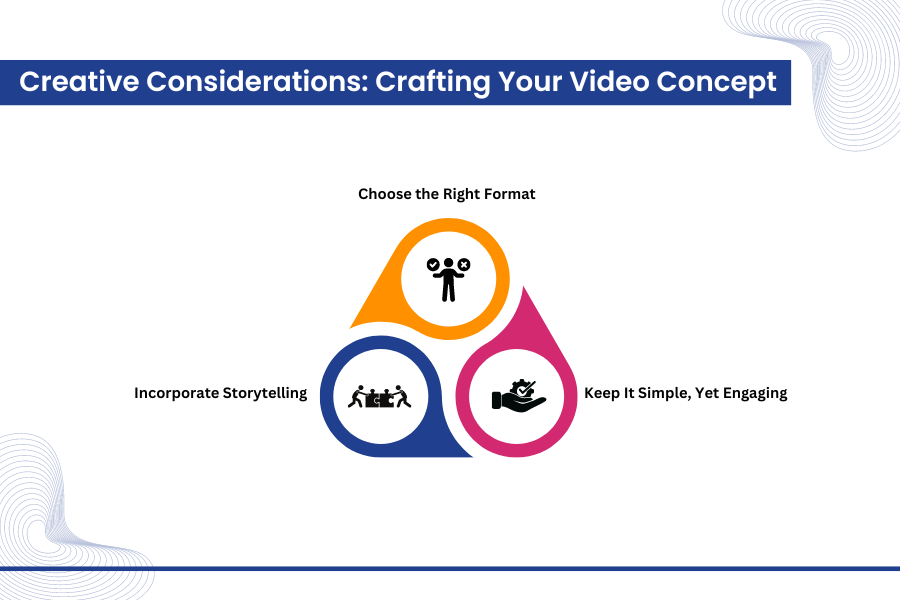Videos for marketing are trending everywhere. From social media platforms to different industries, everyone is utilizing video content to stand out. Whether you’re a startup trying to establish your presence or a business expanding its digital footprint, video content holds the power to engage audiences like never before.
But here’s the catch—before you can create a killer marketing video, you need something even more critical: a well-thought-out brief.
A foolproof video marketing brief is the foundation that can make or break your campaign. If done right, it saves time, ensures a smooth production process, and delivers a video that hits the mark. Whether you’re working with an agency, an in-house team, or doing it yourself, a solid brief keeps everyone aligned.
Let’s have a look at this blog on how to write a foolproof brief for your video marketing campaign.
Why Do You Need a Video Marketing Brief?
Think of your brief as the blueprint for your campaign. Just like you wouldn’t build a house without a solid foundation, you can’t create an impactful video without a well-planned brief.
- Clarity and Direction: A well-structured brief ensures everyone understands the campaign’s goals and direction, eliminating confusion and miscommunication.
- Time Saver: By clearly outlining your objectives, you avoid costly back-and-forth revisions, keeping the project on time and within budget.
- Budget-Friendly: Whether you’re going for low-budget video production tips or planning a more comprehensive video marketing campaign, a detailed brief helps maximize every penny and utilize resources well.
How to Write a Video Marketing Brief
Creating a successful video marketing campaign starts with a well-crafted brief. A comprehensive brief ensures that everyone involved in the project understands the goals, target audience, and key messages. Here’s a breakdown of the steps involved to ensure your campaign delivers results, even if you’re working with inexpensive marketing video tools or opting for a DIY video marketing approach.

1. Define Your Objective
Before you even think about cameras, lights, or scripts, you need to ask yourself, “What do I want this video to achieve?”
- Are you introducing a product?
- Are you looking to drive website traffic?
- Do you want to build brand awareness?
Other Common Objectives can be –
- Boosting sales
- Generating leads
- Engage with your audience
| Pro Tip: Be specific – A clear video marketing goals and objectives set the tone for everything that follows. Instead of saying, “We want more engagement,” try, “We aim to increase social media shares by 20% in three months.” |
2. Know Your Audience
Understanding who you’re talking to is key to creating content that resonates. Narrow down your audience based on the following:
- Demographics (age, gender, location)
- Psychographics (Behaviour interests, values, lifestyle)
- Pain points and Challenges
- Preferred platforms for consuming video content
- Do they prefer short, snappy videos or long, detailed explainer content?
3. Key Messages and Call to Action (CTA)
Outline the key messages you want to convey in your video. What should the audience take away from it? Also, specify the call to action:
- Visit your website
- Sign up for a newsletter
- Download a resource
- Make a purchase
This is where the effective video marketing brief template comes into play, ensuring your messages are aligned.
4. Set Your Budget and Costs
This step is crucial, especially if you’re looking to create video content on a budget. Be realistic about how much you can spend for:
- Scriptwriting
- Filming and editing
- Talent and crew
- Equipment and location
- Post-production (graphics, sound, etc.)
- Promotion (social media ads, influencer partnerships, etc.)
These video production brief tips will help you manage your budget effectively, even if you’re opting for DIY video marketing.
5. Outline Your Core Message
What’s the one thing your audience should remember after watching your video? This message should be clear, concise, and directly tied to your campaign’s objective. Avoid trying to squeeze too many ideas into one video—it dilutes your impact.
6. Expected ROI
Estimate the return on investment (ROI) for your video marketing campaign. Consider factors such as:
- Lead Generation: How many leads do you expect to generate?
- Conversion Rate: What percentage of leads do you expect to convert into customers?
- Sales Increase: How much revenue do you anticipate from the campaign?
- Engagement Metrics: How will you measure engagement (views, likes, shares, comments)?
Being clear on your video marketing goals and objectives helps in tracking ROI.
7. Timeline and Milestones
Set a realistic timeline for the project, including key milestones such as:
- Script approval
- Filming dates
- Editing and revisions
- Final delivery
- Launch date
| Leave a lasting digital footprint! Let Mediasolz help you craft compelling video content that drives results! Contact us today |
Creative Considerations: Crafting Your Video Concept
Now that you’ve nailed the basics of your brief, it’s time to get creative. Here are some formats to consider when creating a video marketing brief for a business.

1. Choose the Right Format
Videos come in all shapes and sizes. Choosing the right one depends on your goals and the platform you’re targeting. Some ideas include:
- Explainer Videos: Perfect for clarifying a product or service.
- Testimonial Videos: Build trust by showcasing real customer stories.
- Behind-the-Scenes Videos: Give your audience a sneak peek into your process.
- Product Demos: Highlight important features and their impact.
- Animated Videos: Ideal for creative storytelling and engaging visuals.
- Live-Action Videos: Perfect for showcasing real people and environments.
2. Keep It Simple, Yet Engaging
Sometimes, simplicity works best. You don’t need Hollywood-level production to create an impactful video. In fact, some of the best marketing videos are straightforward and to the point.
| Pro Tip: Tools like Canva, Animoto, or even iMovie can help you create professional-looking videos even when you’re not a pro. |
3. Incorporate Storytelling for Emotional Impact
Storytelling adds an emotional layer to your video, making it more relatable and memorable. Instead of just delivering facts, weave a narrative that resonates with your audience. Consider formats like:
- Customer Journey Videos: Showcase how your product or service has transformed a real customer’s experience.
- Brand Origin Stories: Share the story behind your brand to build trust and establish a deeper connection.
- Problem-Solution Scenarios: Highlight common challenges your audience faces and demonstrate how your offering provides a solution.
Final Touch: Distribution and Promotion
Once your video is good to go, it’s time to share it with the audience! But don’t just upload and hope for the best. A solid distribution strategy is key to getting your video in front of the right audience.

1. Social Media Blitz
Make use of most of the social channels for maximum exposure. Tailor your videos for each platform, ensuring the format and messaging align with the audience there. Instagram, TikTok, YouTube, and LinkedIn all have different best practices for video content.
2. Email Marketing Campaigns
Don’t forget to integrate your video into your email campaigns. Studies show that adding video to emails can boost click-through rates by up to 300%. It’s an effective and often underutilized way to get more eyes on your content.
3. Engage Your Audience
Make sure to track and measure the performance of your video. Use metrics and KPIs like –
- Views count,
- Engagement rate (likes, shares, and comments) to understand what resonates with your audience.
- Click-through rate (CTR)
- Conversion rate
- Return on investment (ROI)
Then, adjust your future content based on what’s working.
| Thinking to start your video marketing success? From affordable video production to expert distribution and promotion, Mediasolz got you covered. Start Your Campaign Today |
4. Collaborate with Influencers or Customers
Sometimes, the best content comes from those already engaged with your brand. Consider collaborating with influencers or even your most loyal customers to co-create content. User-generated content is often more relatable and influential.
5. Paid advertising (PPC, social media ads)
While organic reach is essential, don’t overlook the power of paid advertising to amplify your video’s impact. Platforms like Google, Facebook, Instagram, and YouTube offer highly targeted ad options to put your video in front of your ideal audience. Let’s see how we can promote it on these social media platforms:
- Google Ads & YouTube Ads: Target users based on keywords, search intent, or specific channels.
- Facebook & Instagram Ads: Use detailed targeting options to reach potential customers with your video content.
- LinkedIn Ads: Perfect for B2B video campaigns, targeting professionals by industry, job title, or company size.
Paid ads ensure that your video gets in front of the right people, driving higher visibility, and engagement, and potentially increasing conversions, giving you a higher ROI.
Ready to Launch Your Next Video Marketing Campaign?
A well-crafted brief is the foundation of a successful video marketing campaign. By clearly defining your objectives, target audience, key messages, and promotional strategies, you can create compelling videos that generate engagement and leads.
At Mediasolz, we specialize in delivering “Built to Suit” video services designed to meet your business’s unique needs—without draining your wallet. Whether you’re a content creator, entrepreneur, or small business, we offer solutions that save time, increase reach and brand awareness, and deliver results.
Let’s bring your vision to life! Contact us today to discuss your next video marketing campaign.
Frequently Asked Questions
How do you write a video marketing brief?
To write a video marketing brief, start by defining the campaign's objective, identify your target audience, outline the key message, and include a clear call to action (CTA).
Next, set a budget, establish a timeline, and provide any creative guidelines related to brand elements, tone, and style. Include the platforms where the video will be shared and how success will be measured.
Why is a video marketing brief important?
A video marketing brief is important because it provides a clear roadmap for the entire video production process. It ensures that all stakeholders are aligned on goals, creative direction, messaging, and timelines, reducing miscommunication and ensuring that the video achieves its intended purpose.
What should be included in a video marketing brief?
A video marketing brief should include the following components:
- Objective of the video campaign
- Target audience profile
- Key message and value proposition
- Call to action (CTA)
- Budget and timeline
- Platform distribution strategy
- Brand guidelines (tone, style, colors, etc.)
- Metrics to measure success
What role does a call to action (CTA) play in the brief?
A call to action (CTA) guides the audience on the next steps after watching the video. It’s crucial for driving engagement, whether it’s to visit a website, sign up for a newsletter, purchase a product, or share a video. A well-crafted CTA can significantly improve the effectiveness of the video in achieving its marketing goals.
How can I measure the success of my video marketing campaign?
You can measure the success of your video marketing campaign by tracking key performance indicators (KPIs) such as:
- Views and engagement rates (likes, comments, shares)
- Click-through rate (CTR) for the CTA
- Conversion rates (leads or sales generated from the video)
- Audience retention and watch time
- Social media metrics (reach, impressions, interactions)
- ROI (Return on Investment) based on the campaign's cost and generated revenue.
What is the best way to align the video with our brand messaging?
To align the video with your brand messaging, ensure that the script, tone, style, and visuals reflect your brand’s identity and values. Use consistent colors, fonts, and logos, and maintain a tone that resonates with your audience. Reinforce your key brand messages throughout the video and include a CTA that aligns with your brand’s objectives.
How can I optimize the video for different platforms?
Each platform has different audience behaviors and technical requirements. To optimize a video for various platforms:
- Adjust video length: Keep it shorter for platforms like Instagram and TikTok and longer for YouTube or your website.
- Format and aspect ratios: Use 16:9 for YouTube and Facebook, 1:1 for Instagram, and vertical 9:16 for Stories or TikTok.
- Subtitles and captions: Many viewers watch without sound, so including captions can improve engagement.
- Platform-specific CTAs: Tailor CTAs based on the platform, like "swipe up" for Instagram Stories or "subscribe" for YouTube.
- Thumbnails and descriptions: Craft engaging thumbnails and use keywords in video titles and descriptions to improve searchability on platforms like YouTube.
How do I account for the budget and timeline in the video marketing brief?
In the video marketing brief, you should define the budget upfront, outlining costs for production, post-production, talent, equipment, and distribution. Also, include a timeline for each phase of the production process, from scripting to final edits. Be realistic about deadlines and budget constraints, ensuring there is room for potential adjustments.
How do I define the target audience in the video marketing brief?
To define the target audience in a video marketing brief, consider demographic factors like age, gender, location, income, and education. Also, psychographics should be analyzed, including their interests, pain points, and buying behaviors. Create audience personas to provide a detailed understanding of who the video should speak to and how it should engage them effectively.


